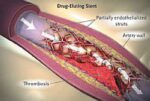Original title: Incidence and predictors of stent trombosis: a single-centre study of 5833 consecutive patients undergoing coronary artery stenting Reference: Javaid Iqbal et al. EuroInterventional 2013;9:62-69 Though potentially fatal, stent thrombosis is a low frequency event associated to stent malapposition, fractures, resistance to antiplatelet therapies, and diseases such as diabetes and kidney disease, among other factors. 5883 pacients<a href="https://solaci.org/en/2013/05/31/stent-thrombosis-in-the-real-world/" title="Read more" >...</a>
Hybrid revascularization, combining strengths in high-risk patients
Original title: One-Stop Hybrid Coronary Revascularization versus Coronary Artery Bypass Graft and Percutaneous Coronary Intervention for the Treatment of Multivessel Coronary Artery Disease: Three-Year Follow-up Results from A Single Institution. Reference: Liuzhong Shen et al. J Am Coll Cardiol Intv 2013. Article in press. Accepted Manuscript. A mammary bridge to anterior descending artery (LMCA) with a permeability ><a href="https://solaci.org/en/2013/05/03/hybrid-revascularization-combining-strengths-in-high-risk-patients/" title="Read more" >...</a>
A real challenge: Primary PCI on an Unprotected Left Main Coronary Culprit Lesion
Original title: A Systematic Review and Meta-Analysis on Primary Percutaneous Coronary Intervention on an Unprotected Left Main Coronary Artery Culprit Lesion in the setting of Acute Myocardial Infarction Reference: Marije M. Vis et al. J Am Coll Cardiol Intv 2013;6:317–24 Acute myocardial infarction with a significantly compromised unprotected left main coronary artery culprit lesion is relatively rare (4%<a href="https://solaci.org/en/2013/04/24/a-real-challenge-primary-pci-on-an-unprotected-left-main-coronary-culprit-lesion/" title="Read more" >...</a>
Colchicine could reduce restenosis in diabetic patients treated with BMS
Original title: Colchicine Treatment for the Prevention of Bare-Metal Stent Restenosis in Diabetic Patients. Reference: Spyridon Deftereos et al. J Am Coll Cardiol 2013;61:1679–85. In stent restenosis is more frequent in diabetic patients, who therefore find DES particularly beneficial. However, there is a subset of these patients with contraindication to prolonged double antiaggregation, due to a programmed surgery<a href="https://solaci.org/en/2013/04/23/colchicine-could-reduce-restenosis-in-diabetic-patients-treated-with-bms/" title="Read more" >...</a>
First results of bioabsorbable metal scaffolds DREAMS
Original title: Safety and performance of the drug-eluting absorbable metal scaffold (DREAMS) in patients with de-novo coronary lesions: 12 month results of the prospective, multicentre, first-in-man BIOSOLVE-I trial. Reference: Michael Haude et al. Lancet 2013; 381: 836–44. Bioabsorbable scaffolds could improve vasomotion, remodelling and facilitate new interventions, both percutaneous and surgical. This new bioabsorbable scaffold, different from the<a href="https://solaci.org/en/2013/04/18/first-results-of-bioabsorbable-metal-scaffolds-dreams/" title="Read more" >...</a>
5 Year Follow Up Outcome of Zotarolimus Eluting Stent
Original title: The “Final” 5-Year Follow-Up From the ENDEAVOR IV Trial Comparing a Zotarolimus-Eluting Stent With a Paclitaxel-Eluting Stent. ENDEAVOR IV Investigators Reference: Ajay J. Kirtane et al. J Am Coll Cardiol Intv 2013. Article in press. The ENDEAVOR IV was a randomized controlled study with a noninferiority design that compared the Endeavor zotarolimus eluting stent (Medtronic, Santa<a href="https://solaci.org/en/2013/04/12/5-year-follow-up-outcome-of-zotarolimus-eluting-stent/" title="Read more" >...</a>
IVUS improves outcomes in long lesions with DES
Original title: Randomized Comparison of Clinical Outcomes between Intravascular Ultrasound and Angiography-Guided Drug-Eluting Stent Implantation for Long Coronary Artery Stenosis. Reference: Jung-Sun Kim et al. J Am Coll Cardiol Intv 2013. Article in press. Treating long lesions is difficult and the chance of instant thrombosis may be higher in these lesions. Coronary intravascular ultrasound (IVUS) can help in<a href="https://solaci.org/en/2013/04/11/ivus-improves-outcomes-in-long-lesions-with-des/" title="Read more" >...</a>
The largest series of femoropopliteal in-stent restenosis to date
Original title: Treatment of Femoropopliteal In-Stent Restenosis With Paclitaxel-Eluting Stents. Zilver PTX Global Registry. ZILVER-PTX. Reference: Thomas Zeller et al. J Am Coll Cardiol Intv 2013;6:274–81. Femoropopliteal in-stent restenosis (ISR) is reported in between 19% and 37% of lesions a year and this incidence increases with lesion length. The ZILVER-PTX study tested the self-expanding paclitaxel-eluting nitinol stent (Cook<a href="https://solaci.org/en/2013/04/08/the-largest-series-of-femoropopliteal-in-stent-restenosis-to-date/" title="Read more" >...</a>
Paclitaxel eluting balloon in the femoropopliteal region
Original title: Paclitaxel-Coated Versus Uncoated Balloon Angioplasty Reduces Target Lesion Revascularization in Patients With Femoropopliteal Arterial Disease. A Meta-Analysis of Randomized Trials. Reference: Salvatore Cassese et al. Circ Cardiovasc Interv. 2012;5:582-589. Balloon angioplasty is one of the most frequent alternatives used in patients with peripheral vascular disease, especially in the femoropopliteal region. However, its effectiveness is reduced in<a href="https://solaci.org/en/2013/03/27/paclitaxel-eluting-balloon-in-the-femoropopliteal-region/" title="Read more" >...</a>
Coronary angioplasty reduces the risk of spontaneous myocardial infarction in chronic stable patients.
Original title: Percutaneous Coronary Intervention Versus Optimal Medical Therapy for Prevention of Spontaneous Myocardial Infarction in Subjects With Stable Ischemic Heart Disease. Reference: Sripal Bangalore et al. Circulation. 2013;127:769-781 In the context of coronary angioplasty complications may arise, such as a periprocedural infarction. However, this event does not have the same clinical consequences compared to a spontaneous infarction. <a href="https://solaci.org/en/2013/02/26/coronary-angioplasty-reduces-the-risk-of-spontaneous-myocardial-infarction-in-chronic-stable-patients/" title="Read more" >...</a>









